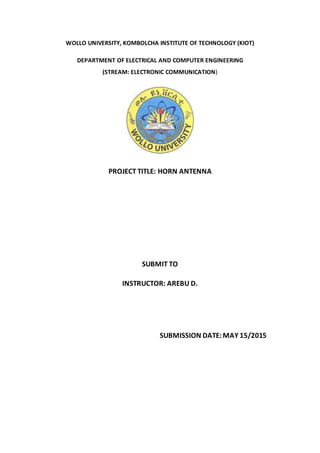The document outlines a project on horn antennas, detailing their design, parameters, and applications in microwave technology. It discusses the historical background, fundamental characteristics such as radiation pattern, gain, and efficiency, as well as design considerations to optimize performance. The goal is to create an affordable horn antenna for effective transmission and reception of radio waves.






![WOLLO UNIVERSITYKIOT PROJECTON HORN ANTENNA
Page | 7
Chapter 2: Fundamental Parameters Of HornAntenna
2.1 Horn AntennaRadiationPattern
The waves travel down a horn as spherical wave fronts, with their origin at the apex
of the horn, a point called the phase center. The pattern of electric and magnetic fields
at the aperture plane at the mouth of the horn, which determines the radiation pattern,
is a scaled-up reproduction of the fields in the waveguide. Because the wave fronts
are spherical, the phase increases smoothly from the edges of the aperture plane to the
center, because of the difference in length of the center point and the edge points from
the apex point. The difference in phase between the center point and the edges is
called the phase error. This phase error, which increases with the flare angle, reduces
the gain and increases the beam width, giving horns wider beam widths than similar-
sized plane-wave antennas such as parabolic dishes.
At the flare angle, the radiation of the beam lobe is down about −20 dB from its
maximum value. As the size of a horn (expressed in wavelengths) is increased, the
phase error increases, giving the horn a wider radiation pattern. Keeping the beam
width narrow requires a longer horn (smaller flare angle) to keep the phase error
constant. The increasing phase error limits the aperture size of practical horns to about
15 wavelengths; larger apertures would require impractically long horns. This limits
the gain of practical horns to about 1000 (30 dBi) and the corresponding minimum
beam width to about 5 - 10°.
2.2 Horn AntennaGain
Horns have very little loss, so the directivity of a horn is roughly equal to its gain.[1] The
gain G of a pyramidal horn antenna (the ratio of the radiated power intensity along its beam
axis to the intensity of an isotropic antenna with the same input power) is:[14]
G = 4πA / λ2 eA eqn 2.1
For conical horns, the gain is:
G = (πd /λ )2 eA eqn 2.2
where
A is the area of the aperture,
d is the aperture diameter of a conical horn
λ is the wavelength,
eA is a dimensionless parameter between 0 and
1 called the aperture efficiency.](https://image.slidesharecdn.com/hornantenna-150515213411-lva1-app6892/85/Horn-antenna-project-report-7-320.jpg)






![WOLLO UNIVERSITYKIOT PROJECTON HORN ANTENNA
Page | 14
ZA= antenna impedance (ohms)
RA= antenna resistance (ohms)
XA=antenna reactance (ohms)
The resistive part
RA = Rr + RL eqn 2.12
Where
Rr= radiation resistance of the antenna
RL= loss resistance of the antenna
The input impedance of an antenna is generally a function of frequency. Thus, the antenna
will be matched to the interconnecting transmission line and other associated equipment only
within a bandwidth. In addition, the input impedance of the antenna depends on many factors
including its geometry, its method of excitation, and its proximity to surrounding objects.
Because of their complex geometries, only a limited number of practical antennas had been
investigated analytically. For many others, the input impedance has been determined
experimentally
Chapter 3: HornAntennaDesign
3.1 design Considerations
Horns are among the simplest and most widely used microwave antennas and they
find applications in the areas of wireless communications, electromagnetic
sensing RF heating and biomedicine . The horn antenna may be considered as an RF
transformer or impedance match between the waveguide feeder and free space
which has an impedance of 377 ohms by having a tapered or having a flared end to
the waveguide. Horn antenna offers several benefits when employed in that
besides matching the impedance of the guide to that of free space or vice versa, it
helps suppress signals travelling via unwanted modes in the waveguide from
being radiated and it provides significant level of directivity and gain . While it serves
as entry medium for signal interception for processing in the case of
receiving systems, it serves in the case of transmission to illuminate dish antenna
from its focal area estimated from the f/d parameters of the parabolic dish . Dual
mode feed horns often provide excellent performance over wide range of
microwave bands. Some design considerations of horn antennas are :
A) Impedance consideration
Impedance matching is very desirable with radio frequency transmission lines.
Standing waves lead to increased losses and frequently cause the transmitted to
malfunction [5].When one considers a waveguide without a horn in operation,
the sudden interface of the conductive walls or free air as the case may be for](https://image.slidesharecdn.com/hornantenna-150515213411-lva1-app6892/85/Horn-antenna-project-report-14-320.jpg)





